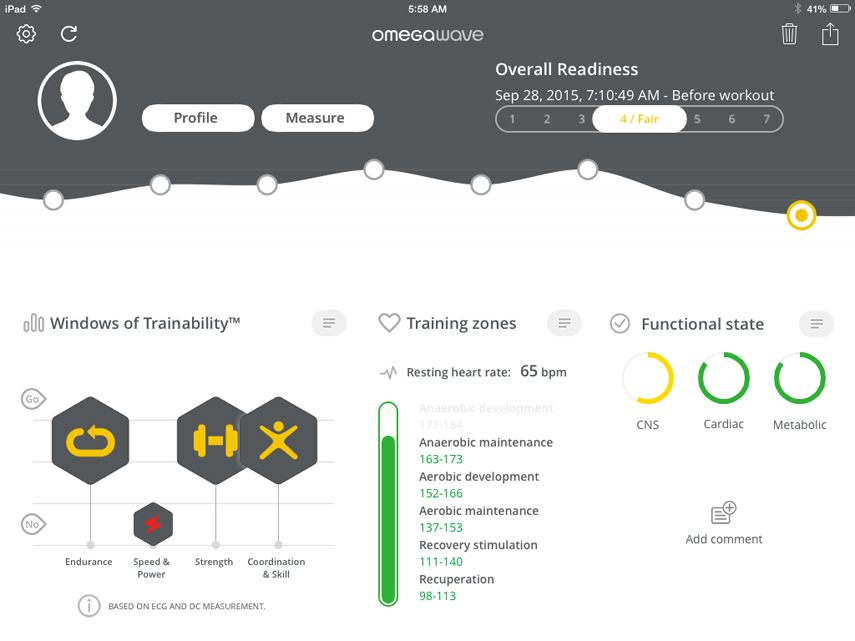Let me try to explain some of the more basic concepts about biological regulation as it relates to adaptation and the use of Omegawave.
The body is a dynamic system, consisting of many subsystems at different levels. This includes various organs and physiological systems, such as the cardiorespiratory system, neuromuscular system, endocrine system (glands) and so forth.
We can also go deeper and start separating, for example, the endocrine system into specific hormones, including anabolic hormones like testosterone, growth hormone, and insulin, as well as catabolic hormones like cortisol and glucagon.
In addition to understanding that the body is a multi-layer system, we must also grasp that the body exists in a state of constant change. These changes, though, might differ significantly in scale. Just look at the frequency ranges of various biological oscillations: brainwaves from 1-50 Hz, heart rate frequency from 0.5-3.5 Hz, turnover rate of red blood cells in 120 days, or bone cells of only 2-3% a year. These oscillations are necessary for creating optimal adaptations to environmental changes and for conserving energy when possible.
Some of these parameters are more stable over time and the body expends little effort in keeping them relatively stable (examples include temperature, blood glucose levels or body weight). Other parameters—such as heart rate, oxygen uptake, muscular activity and blood pressure—vary far more over time. This variance comes in response to the actual demands of the environment.
To see this phenomenon concretely, just sit in a chair and measure your heart rate and blood pressure. Then, quickly stand up and take the same measurements again: you will see relatively large changes in both. This physical stimulus—standing suddenly—demands changes in blood pressure and heart rate, which are regulated by the autonomic nervous system. If, however, the heart rate, blood pressure or HRV do NOT change in response to this small stimulus, the regulation systems (mainly the autonomic nervous system), are not functioning well. In this case, the failure of the regulatory systems would result in dizziness, or possibly even fainting.
Not surprisingly, this test is very often used for assessing the normal functioning of the regulatory systems.
Omegawave enters this picture at a critical juncture: essentially, what Omegawave measures is regulation. Hence, the Omegawave Readiness test gives you a useful set of parameters for different physiological systems and their state of regulation. The central nervous system, the autonomic nervous system and the hormonal system are mainly regulatory systems, safeguarding the integrity and stability of the organism against external influences in the short-term (e.g., the stress of exercise), while providing the conditions for adaptation in the long-term (e.g., via a training program). Basically, these regulatory systems are survival mechanisms, dealing with mental and physical stressors.
As such, Omegawave’s parameters do not tell you how strong you are or how good your endurance is; instead, Omegawave’s indexes offer insight into the regulatory systems that maintain these physical qualities. Are they functioning, or are they compromised? Is your body prepared to create positive and useful adaptations to the stressors of training and your overall environment (work, travel, etc.)? If you find out that one or more of these systems are outside the norms, you will immediately know that your body’s ability to manage and positively adapt to new loads is diminished, allowing you to adjust your future training or other loads accordingly.

In summary, the Omegawave Readiness assessment helps you to better understand how your ENTIRE organism is responding to the combined effects of your training and other environmental stressors. Armed with this information, you can choose when and how to adjust these loads to optimize your training response and overall well being.
Henk Kraaijenhof has worked with elite athletes in many sports. He now works as an international performance consultant in a wide range of fields, including corporations, organisations, military and police. He is an international lecturer in these fields and the author of three books. He has used Omegawave technology since 2001, and his company Vortx is the distributor for Omegawave solutions in Holland, Belgium and Switzerland.
Bibliography: (unfortunately for the English speaking community, a lot of it is in German language)
Gellhorn, E: Autonomic Regulations; Interscience Publ. NY, USA, 1943.
Hoff, F: Klinische Probleme der vegetative Regulation und der Neuralpathologie (in German) (Clinical Problems of Autonomic Regulation and Neural Pathology); George Thieme Verlag, Stuttgart, 1952.
Braines, S.N; Napalkow, A.W; Swetschinski, W.B: Neurokybernetik (in German); (Neurocybernetics); VEB Volk und Gesundheit, Berlin, DDR, 1964.
Parin, V.V; Bayevskiy, R.M: Introduction to Medical Cybernetics; (translated by NASA), July 1967.
Schulkin, J: Rethinking Homeostasis; MIT Press, USA, 2003.
Grigoriev, A.I; Baevsky, R.M: Conception of Health and Problems of Norm in Space Medicine;(in Russian) IBMP, Moscow, 2001.
Mrosovsky, N: Rheostasis. The Physiology of Change; Oxford University Press, USA, 1990.
Hecht, K: Chrono-Psycho-Biologische Regulations-Diagnostik (in German); (Chrono-Psycho-Biological Regulation Diagnostics) in : Hecht, K; Balzer, H-U: Stressmanagement, Katastrophenmedizin, Regulationsmedizin, Praevention; Pabst Publ. Lengerich, 2000.
Perger, F: Kompedium der Regulationspathologie und -Therapie (in German) (Compendium of Regulationpathology and Therapy); Sonntag Verlag, Muenchen, 1990.
